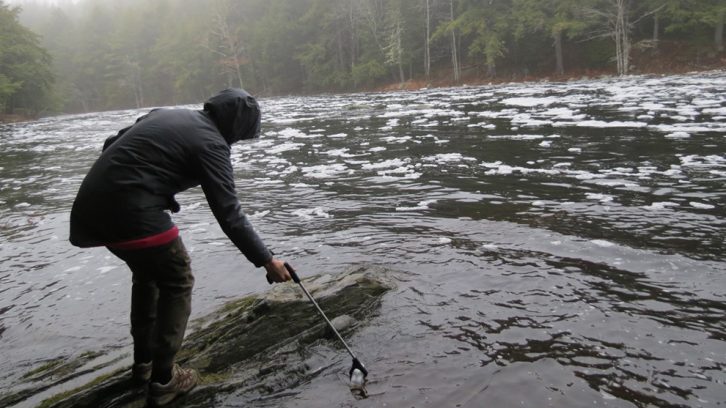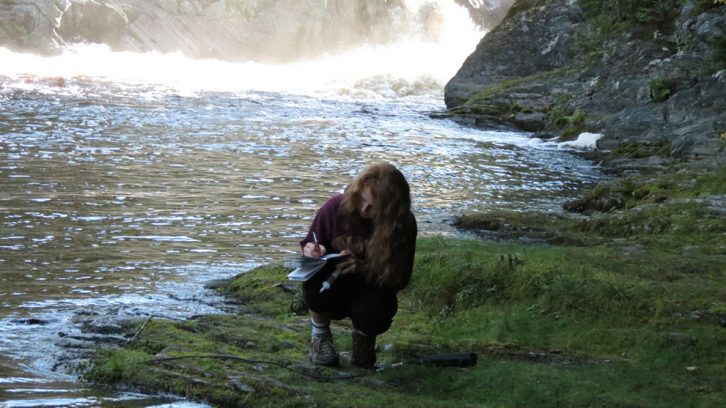Science
New ‘helicopter liming’ technique to help Nova Scotia’s declining Salmon stocks
Dalhousie researchers find toxic ionic aluminum in province's rivers

caption
Salmon stocks have been in decline for 'decades' says Fisheries and Oceans Canada
caption
Salmon stocks have been in decline for ‘decades’ says Fisheries and Oceans CanadaHelicopters are being used to spread garden-variety lime in an effort to help the provinces ailing salmon stocks.
This collaborative project has brought the Nova Scotia Salmon Association (NSSA), Fisheries and Oceans Canada and Dalhousie University Earth Sciences researchers together in order to strengthen salmon ecosystems.
As for the root cause of this decline, Earth Sciences researcher Sarah MacLeod says her work offers an answer as to what’s been killing these fish.
She says her research proves that the total amount of aluminum found in Nova Scotia’s rivers has risen considerably in recent decades and that ionic aluminum levels remain toxic, more than a decade after it was first reported by Tom Clair of Environment Canada.
“Increases in aluminum and their effects on salmon, that is something that is new to Nova Scotia,” MacLeod says. “But the idea that acidification is a problem, that’s been known for a while.”
MacLeod says the root of the problem lies in carbon emission because “our emissions have been declining, but it’s still not enough.”
Louise de Mestral, an aquatic science biologist with Fisheries and Oceans Canada, told The Signal that “declines (in salmon) have been quite pronounced over the past several decades.”
She says salmon populations in the Southern and Eastern Shore areas of Nova Scotia have declined “88 to 98 per-cent since the 80s.”
That’s disconcerting to de Mestral because a slight imbalance in habitat health can negatively impact salmon populations. She says many factors are to blame for the smaller numbers including the building of dams and culverts, invasive species, diseases, as well as illegal poaching.
On top of these problems, salmon face genetic threats caused by inbreeding due to low populations.
But a leading factor behind the decline, she believes, is the acidification.
This is generally believed within scientific and angling circles. However, researchers at Dalhousie have been finding new evidence they hope can make a “definitive case” that toxic aluminum, brought on by acidification, is to blame for the decline.
MacLeod says Nova Scotia faces a higher than normal threat from emissions as the province is at the end of a “tail pipe” formed by two different major air currents.
One of those currents brings carbon emissions from cities to the west like Toronto, Detroit and Windsor. The other brings carbon-filled air up the Atlantic coast from Philadelphia, New York and Boston.
Sulfates and nitrates from these cities float along those air currents and finally land in Nova Scotia in the form of acid rain.

caption
Sarah MacLeod takes water samples from the Mersey River (photo courtesy of Kai Boggild)MacLeod says these rains hit the ground creating a complex chemical reaction in which nutrients are “stripped away” leaving waterways with a pH imbalance and a high aluminum content that can be toxic to salmon.
MacLeod’s research has seen her examine over 65 rivers in Nova Scotia since 2015. She has found that over half have concentrations of aluminum, with 35 per-cent surpassing the toxic threshold of 15 micrograms per litre.
Other rivers like West River Sheet Harbour, Sackville and Maria Brook have concentrations as high as seven times the toxic threshold for salmon at 107 micrograms per litre.
MacLeod further focused her research to look at ionic aluminum, a particularly toxic form of the mineral. She explains that ionic aluminum is a positively charged mineral, while salmon gills are negatively charged.
This means that as salmon swim ionic aluminum binds to their gills, “like a magnet,” and slowly chokes the fish to death.

caption
Sarah MacLeod takes notes on the Mersey River (photo courtesy of Kai Boggild)While MacLeod worries about these salmon, she says she is more concerned that the increase in aluminum could be a sign that “greater declines in more types of species” will occur throughout the province.
These worries are understood by Eddie Halfyard, research scientist with the Nova Scotia Salmon Association.
Halfyard and the Salmon Association, along with Fisheries and Oceans, Dalhousie and some 11 partners in total are currently undertaking a helicopter, or “catchment” liming project on West River Sheet Harbour in an effort to save these habitats.
Halfyard says the Greater West River Acid Mitigation Project has been spreading calcium carbonate, or agricultural lime, in the area since 2005 on a small scale.
The project is working he says. Juvenile salmon, known as parr and smolts, have seen their population quadruple in the river since the beginning of the project.
Since the fall of 2016, this new aerial phase of the project has spread 625 tonnes of lime over 66 hectares of land so far. This roughly equates to spreading 60 dump truck loads of lime over 80 soccer fields.
Halfyard says the purpose of lime “dosing” is to add calcium carbonate back to the soils and to reset the pH level of the river, making it less acidic.
As rain passes through the soil, the lime is dragged down into the rivers, bringing vital nutrients to where the salmon are.
The newly treated soils can have positive long term affects on the ecosystem for up to 20 years.
As the project continues, MacLeod and other researchers will be monitoring the water quality of West River Sheet Harbour, checking to see how the lime is affecting aluminum concentrations.
But while this project is underway, MacLeod wishes that such tremendous efforts weren’t a necessity in order to fix our own damaged environment.
In the end MacLeod blames carbon emissions as the overall culprit. She says that in order to mitigate acidification, replenish salmon stocks and save more Nova Scotian wildlife, there needs to be greater international efforts to reduce emissions.
“If we are going to avoid further damage to our ecosystems then everyone will need to cut emissions,” she says.

